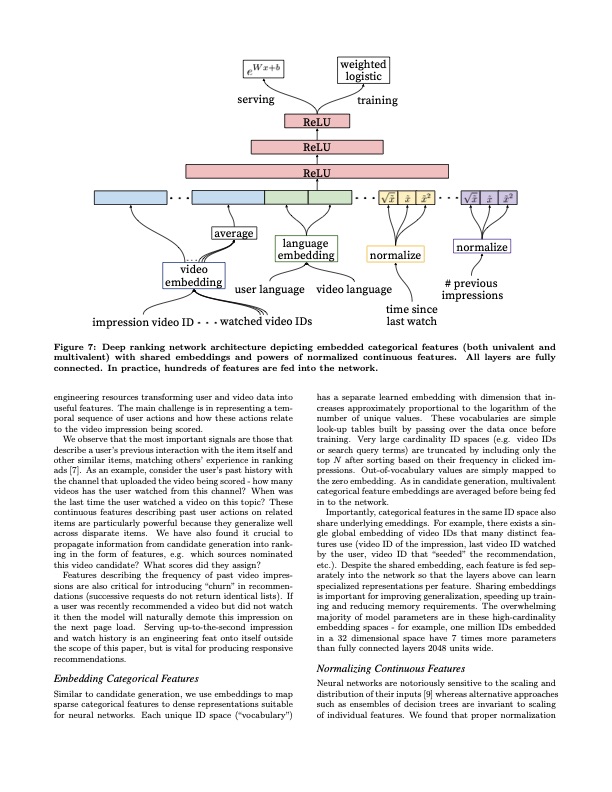
PDF Publication Title:
Text from PDF Page: 006
serving training ReLU ReLU ReLU user language video language time since impression video ID watched video IDs last watch # previous impressions Figure 7: Deep ranking network architecture depicting embedded categorical features (both univalent and multivalent) with shared embeddings and powers of normalized continuous features. All layers are fully connected. In practice, hundreds of features are fed into the network. engineering resources transforming user and video data into useful features. The main challenge is in representing a tem- poral sequence of user actions and how these actions relate to the video impression being scored. We observe that the most important signals are those that describe a user’s previous interaction with the item itself and other similar items, matching others’ experience in ranking ads [7]. As an example, consider the user’s past history with the channel that uploaded the video being scored - how many videos has the user watched from this channel? When was the last time the user watched a video on this topic? These continuous features describing past user actions on related items are particularly powerful because they generalize well across disparate items. We have also found it crucial to propagate information from candidate generation into rank- ing in the form of features, e.g. which sources nominated this video candidate? What scores did they assign? Features describing the frequency of past video impres- sions are also critical for introducing “churn” in recommen- dations (successive requests do not return identical lists). If a user was recently recommended a video but did not watch it then the model will naturally demote this impression on the next page load. Serving up-to-the-second impression and watch history is an engineering feat onto itself outside the scope of this paper, but is vital for producing responsive recommendations. Embedding Categorical Features Similar to candidate generation, we use embeddings to map sparse categorical features to dense representations suitable for neural networks. Each unique ID space (“vocabulary”) has a separate learned embedding with dimension that in- creases approximately proportional to the logarithm of the number of unique values. These vocabularies are simple look-up tables built by passing over the data once before training. Very large cardinality ID spaces (e.g. video IDs or search query terms) are truncated by including only the top N after sorting based on their frequency in clicked im- pressions. Out-of-vocabulary values are simply mapped to the zero embedding. As in candidate generation, multivalent categorical feature embeddings are averaged before being fed in to the network. Importantly, categorical features in the same ID space also share underlying emeddings. For example, there exists a sin- gle global embedding of video IDs that many distinct fea- tures use (video ID of the impression, last video ID watched by the user, video ID that “seeded” the recommendation, etc.). Despite the shared embedding, each feature is fed sep- arately into the network so that the layers above can learn specialized representations per feature. Sharing embeddings is important for improving generalization, speeding up train- ing and reducing memory requirements. The overwhelming majority of model parameters are in these high-cardinality embedding spaces - for example, one million IDs embedded in a 32 dimensional space have 7 times more parameters than fully connected layers 2048 units wide. Normalizing Continuous Features Neural networks are notoriously sensitive to the scaling and distribution of their inputs [9] whereas alternative approaches such as ensembles of decision trees are invariant to scaling of individual features. We found that proper normalization weighted logistic average language embedding normalize normalize video embeddingPDF Image | Deep Neural Networks for YouTube Recommendations

PDF Search Title:
Deep Neural Networks for YouTube RecommendationsOriginal File Name Searched:
45530.pdfDIY PDF Search: Google It | Yahoo | Bing
Cruise Ship Reviews | Luxury Resort | Jet | Yacht | and Travel Tech More Info
Cruising Review Topics and Articles More Info
Software based on Filemaker for the travel industry More Info
The Burgenstock Resort: Reviews on CruisingReview website... More Info
Resort Reviews: World Class resorts... More Info
The Riffelalp Resort: Reviews on CruisingReview website... More Info
| CONTACT TEL: 608-238-6001 Email: greg@cruisingreview.com | RSS | AMP |